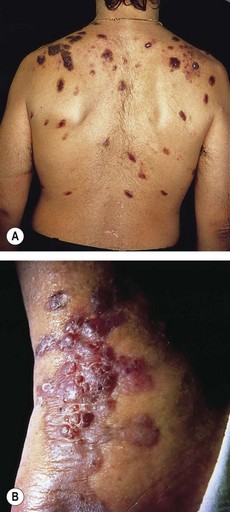180 Kaposi’s sarcoma
Salient features
Advanced-level questions
What are the varieties of Kaposi’s sarcoma?
• Classic Kaposi’s sarcoma or epidemic type (Fig. 108.1B): initially described in Jews; indolent; found on the legs of elderly men; confined to the skin and may be present for decades; not fatal.
• African variety or endemic type (Fig. 180.2): violaceous skin plaques, black under Negroid skin; this is an aggressive invasive tumour that is ultimately fatal. It occurs in children and younger men. In the former it is often associated with generalized lymphadenopathy.
• AIDS-associated Kaposi’s sarcoma (Fig. 180.3): found in approximately one-third of patients with AIDS and more common in homosexuals. The cutaneous lesions respond to interferon-alfa and cytotoxic chemotherapy. About one-third develop a second malignancy such as lymphoma, myeloma or leukaemia. Patients eventually die from a secondary infection seen in AIDS rather than as a direct consequence of Kaposi’s sarcoma.
• Transplantation-associated Kaposi’s sarcoma, particularly in patients on high-dose immunosuppressive therapy; these often regress when therapy is stopped. Transmission of human herpesvirus 8 infection occurs from renal transplant donors to recipients and is a risk factor for Kaposi’s sarcoma (N Engl J Med 1998;339:1358–63).
Stay updated, free articles. Join our Telegram channel

Full access? Get Clinical Tree



